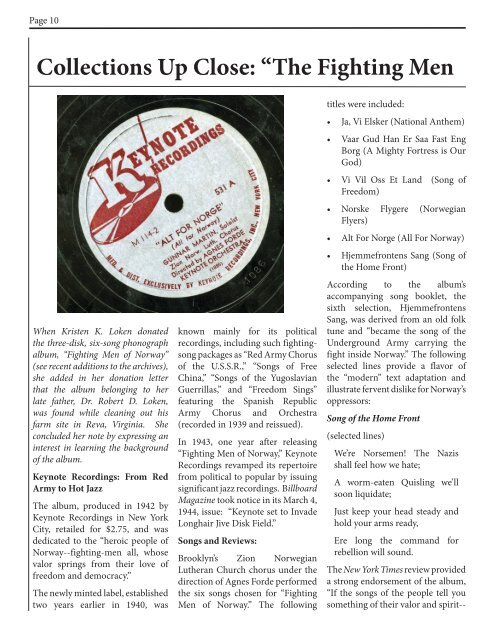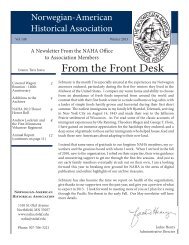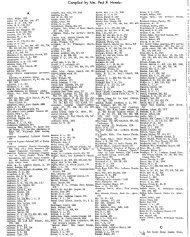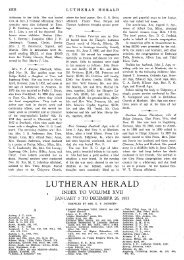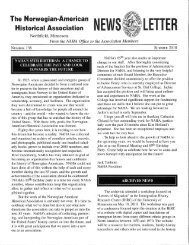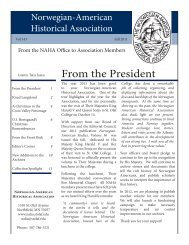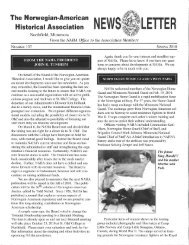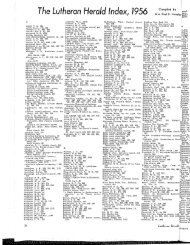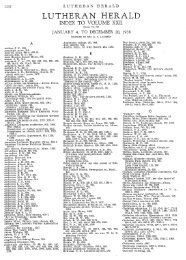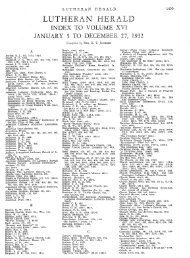Spring 2013 - Norwegian-American Historical Association - St. Olaf ...
Spring 2013 - Norwegian-American Historical Association - St. Olaf ...
Spring 2013 - Norwegian-American Historical Association - St. Olaf ...
Create successful ePaper yourself
Turn your PDF publications into a flip-book with our unique Google optimized e-Paper software.
Page 10<br />
Collections Up Close: “The Fighting Men<br />
When Kristen K. Loken donated<br />
the three-disk, six-song phonograph<br />
album, “Fighting Men of Norway”<br />
(see recent additions to the archives),<br />
she added in her donation letter<br />
that the album belonging to her<br />
late father, Dr. Robert D. Loken,<br />
was found while cleaning out his<br />
farm site in Reva, Virginia. She<br />
concluded her note by expressing an<br />
interest in learning the background<br />
of the album.<br />
Keynote Recordings: From Red<br />
Army to Hot Jazz<br />
The album, produced in 1942 by<br />
Keynote Recordings in New York<br />
City, retailed for $2.75, and was<br />
dedicated to the “heroic people of<br />
Norway--fighting-men all, whose<br />
valor springs from their love of<br />
freedom and democracy.”<br />
The newly minted label, established<br />
two years earlier in 1940, was<br />
known mainly for its political<br />
recordings, including such fightingsong<br />
packages as “Red Army Chorus<br />
of the U.S.S.R.,” “Songs of Free<br />
China,” “Songs of the Yugoslavian<br />
Guerrillas,” and “Freedom Sings”<br />
featuring the Spanish Republic<br />
Army Chorus and Orchestra<br />
(recorded in 1939 and reissued).<br />
In 1943, one year after releasing<br />
“Fighting Men of Norway,” Keynote<br />
Recordings revamped its repertoire<br />
from political to popular by issuing<br />
significant jazz recordings. Billboard<br />
Magazine took notice in its March 4,<br />
1944, issue: “Keynote set to Invade<br />
Longhair Jive Disk Field.”<br />
Songs and Reviews:<br />
Brooklyn’s Zion <strong>Norwegian</strong><br />
Lutheran Church chorus under the<br />
direction of Agnes Forde performed<br />
the six songs chosen for “Fighting<br />
Men of Norway.” The following<br />
titles were included:<br />
• Ja, Vi Elsker (National Anthem)<br />
• Vaar Gud Han Er Saa Fast Eng<br />
Borg (A Mighty Fortress is Our<br />
God)<br />
• Vi Vil Oss Et Land (Song of<br />
Freedom)<br />
• Norske Flygere (<strong>Norwegian</strong><br />
Flyers)<br />
• Alt For Norge (All For Norway)<br />
• Hjemmefrontens Sang (Song of<br />
the Home Front)<br />
According to the album’s<br />
accompanying song booklet, the<br />
sixth selection, Hjemmefrontens<br />
Sang, was derived from an old folk<br />
tune and “became the song of the<br />
Underground Army carrying the<br />
fight inside Norway.” The following<br />
selected lines provide a flavor of<br />
the “modern” text adaptation and<br />
illustrate fervent dislike for Norway’s<br />
oppressors:<br />
Song of the Home Front<br />
(selected lines)<br />
We’re Norsemen! The Nazis<br />
shall feel how we hate;<br />
A worm-eaten Quisling we’ll<br />
soon liquidate;<br />
Just keep your head steady and<br />
hold your arms ready,<br />
Ere long the command for<br />
rebellion will sound.<br />
The New York Times review provided<br />
a strong endorsement of the album,<br />
“If the songs of the people tell you<br />
something of their valor and spirit--


